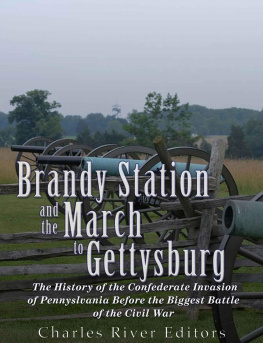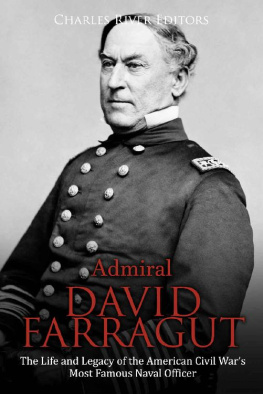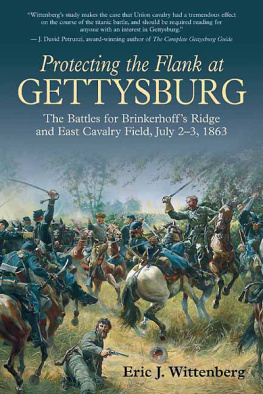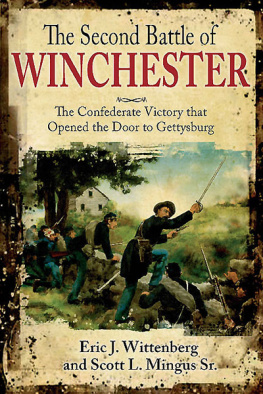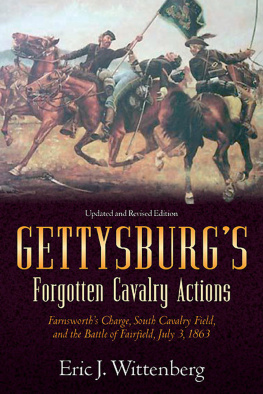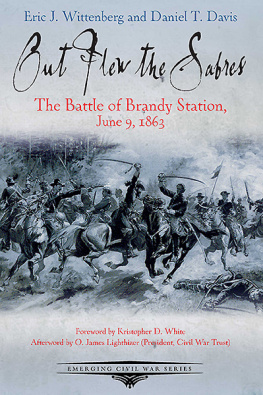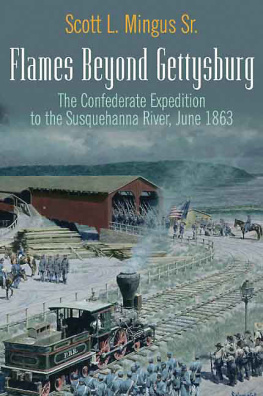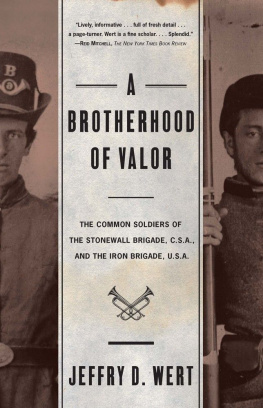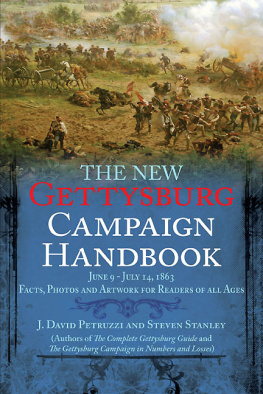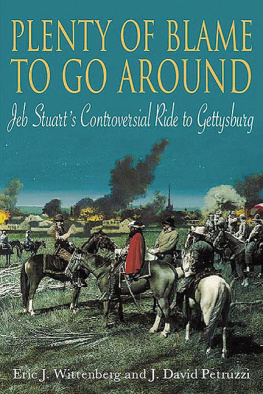Charles River Editors provides superior editing and original writing services across the digital publishing industry, with the expertise to create digital content for publishers across a vast range of subject matter. In addition to providing original digital content for third party publishers, we also republish civilizations greatest literary works, bringing them to new generations of readers via ebooks.
Sign up here to receive updates about free books as we publish them , and visit Our Kindle Author Page to browse todays free promotions and our most recently published Kindle titles.
Introduction

A contemporary illustration depicting the battle
The Invasion of Pennsylvania
In early June 1863, the Confederate Army of Northern Virginia occupied Culpeper, Virginia, and after their victories at Fredericksburg and Chancellorsville against armies twice their size, the Confederate troops felt invincible and anxious to carry the war north into Pennsylvania. One of the proudest was iconic cavalry leader JEB Stuart, who had filled in admirably for the mortally wounded Stonewall Jackson the previous month at Chancellorsville. Back in command of the cavalry, Stuart bivouacked his men near the Rappahannock River, screening the Confederate army against surprise Union attacks.
Buoyed by his recent successes, Stuart held a field review on June 5, but when Lee couldnt attend that one, he held another one in Lees presence on June 8. During that one, the Confederates paraded nearly 9,000 mounted troops and four batteries of horse artillery for review, which included mock battles near Brandy Station. Some of the cavalrymen and newspaper reporters at the scene complained that all Stuart was doing was feeding his ego and exhausting the horses, and he was referred to as a headline-hunting show-off.
Meanwhile, Union Army of the Potomac commander Joseph Hooker interpreted Stuart's presence around Culpeper as a precursor to a raid on his army's supply lines. In response, he ordered his cavalry commander, Maj. General Alfred Pleasonton, to take a combined force of 8,000 cavalry and 3,000 infantry on a raid to "disperse and destroy" the 9,500 Confederates. Crossing the Rappahannock River in two columns on June 9, 1863 at Beverly's Ford and Kelly's Ford, the first infantry unit caught Stuart completely off guard, and the second surprised him yet again.
In addition to being the largest cavalry battle of the war, the chaos and confusion that ensued across the battlefield also made Brandy Station unique in that most of the fighting was done while mounted and using sabers. One account of the battle noted, "Of the bodies that littered the field that day, the vast majority were found to have perished by the sword." After 10 hours of charges and countercharges that swept back and forth across Fleetwood Hill involving drawn sabers and revolvers, Pleasonton decided to withdraw his exhausted men across the Rappahannock River. Stuart immediately claimed a Confederate victory because his men had managed to hold the field and inflicted more casualties on the enemy while forcing Pleasonton to withdraw before locating Lee's infantry, but Stuart was trying to save face, and nobody else, including Lee, shared his view of the battle. The fact was that the Southern cavalry under Stuart had not detected the movement of two large columns of Union cavalry and had fallen prey to not one but two surprise attacks. Two days later, the Richmond Enquirer reported, If Gen. Stuart is to be the eyes and ears of the army we advise him to see more, and be seen less. Gen. Stuart has suffered no little in public estimation by the late enterprises of the enemy.
As Lees army moved into Pennsylvania, Stuarts cavalry screened his movements, thereby engaging in the more traditional cavalry roles, but its widely believed that he was still smarting over the results of June 9. As a result, many historians think it likely that he had already planned to remove the negative effect of Brandy Station by duplicating one of his now famous rides around the enemy army, much as he did to McClellans Army of the Potomac during the Peninsula Campaign in 1862. This time, however, as Lee began his march north through the Shenandoah Valley in western Virginia, it is highly unlikely that is what he wanted or expected.
Before setting out on June 25, the methodical Lee gave Stuart specific instructions as to the role he was to play in the Pennsylvania offensive. As the eyes of the army, the cavalry was to guard the mountain passes with part of his force while the Army of Northern Virginia was still south of the Potomac River, and then cross the river with the remainder of his army and screen the right flank of Confederate general Richard Stoddert Ewell's II Corps as it moved down the Shenandoah Valley, maintaining contact with Ewell's army as it advanced towards Harrisburg.
Instead of taking the most direct route north near the Blue Ridge Mountains, however, Stuart chose a much more ambitious course of action. Stuart decided to march his three best brigades (under Generals Hampton, Fitzhugh Lee, and Col. John R. Chambliss) between the Union army and Washington, north through Rockville to Westminster, and then into Pennsylvania, a route that would allow them to capture supplies along the way and wreak havoc as they skirted Washington.
To complicate matters even more, as Stuart set out on June 25 on what was probably a glory-seeking mission, he was unaware that his intended path was blocked by columns of Union infantry that would invariably force him to veer farther east than he or Lee had anticipated. Ultimately, his decision would prevent him from linking up with Ewell as ordered and deprive Lee of his primary cavalry force as he advanced deeper and deeper into unfamiliar enemy territory. According to Halsey Wigfall (son of Confederate States Senator Louis Wigfall) who was in Stuarts infantry, Stuart and his cavalry left [Lees] army on June 24 and did not contact [his] army again until the afternoon of July 2, the second day of the [Gettysburg] battle.
According to Stuarts own account, on June 29 his men clashed briefly with two companies of Union cavalry in Westminster, Maryland, overwhelming and chasing them a long distance on the Baltimore road, causing a "great panic" in the city of Baltimore. On June 30, the head of Stuart's column then encountered General Judson Kilpatrick's cavalry as it passed through Hanover, during which they reportedly captured a wagon train and scattered the Union army before Kilpatrick's men were able to regroup and drive Stuart and his men out of town. Then, after a 20 mile trek in the dark, Stuarts exhausted men reached Dover, Pennsylvania on the morning of July 1.
H.B. McClellan would point out in his book about Stuart that Lees orders meant the army commander was aware that under the most favorable circumstances Stuart must be separated from the army for at least three or four days. However, Stuarts cavalry would be gone for 7 days, and Stuart was too far removed from the Army of Northern Virginia to warn Lee of the Army of the Potomacs movements. As it would turn out, Lees army inadvertently stumbled into Union cavalry and then the Union army at Gettysburg on the morning of July 1, 1863, unaware of the force in their front. Stuarts cavalry wouldnt even reach the Army of Northern Virginia until the afternoon of July 2, when the battle was at its fiercest.

